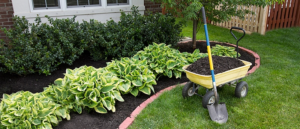A lush, healthy lawn can make a world of difference. When done correctly, routine maintenance practices like mowing and watering are critical to a beautiful, vibrant lawn.
Water early in the morning to allow the grass to dry before the sun causes excess evaporation. Fertilizing regularly and aerating the soil help prevent compaction and thatch buildup so air, water, and nutrients can reach grass roots. Contact Lawn Care Mooresville now!

Lawn mowing is a basic part of lawn care, but how it’s done makes all the difference. A sharp, properly adjusted mower blade delivers a clean cut that prevents soil compaction and encourages grass health. Dull blades rip the grass, which damages it, and leaves jagged edges that invite disease. And mowing too often can actually kill the grass, especially in the hottest parts of the summer.
A proper mowing height varies by season, but is generally in the range of 2 1/2″ – 3″. Taller lawns have more drought resistance and crowd out weeds. Regular mowing also preserves plant and soil moisture, which helps to promote deep roots and make the lawn more resistant to disease.
Mower types include cylinder, rotary, and ride-on mowers. Each type of mower cuts the grass in a different way. For example, a rotary mower spins the blades to cut the grass rather than cutting it in one direction like a cylinder mower. A rotary mower also moves the cuttings out of the way for a clean, neater appearance. A rotary mower is more effective at dealing with tougher, thicker grass than a cylinder mower.
Many basic lawn service packages also include string trimming, which trims ragged edges around fence lines, shrubs, trees and tees. Some companies bag the clippings, while others leave them on the lawn to help improve soil quality and encourage healthy microbial activity.
A well-maintained lawn is a great way to enhance your property’s curb appeal and raise its resale value. In addition to boosting your home’s value, a lush green lawn is healthy for the environment and benefits your overall health by encouraging physical activity and stress reduction. It also reduces air pollution by absorbing carbon dioxide and filtering pollutants from the air and water. It helps keep the soil in place, preventing erosion and sedimentation from entering lakes, rivers, and bays. Finally, it can provide a habitat for birds and wildlife and contribute to a healthier local ecosystem. Proper lawn care can help ensure a beautiful, functional yard that will provide a lifetime of enjoyment for you and your family.
Watering
Watering is one of the most important lawn care tasks that homeowners can do, especially during hot weather. When grass is not getting enough moisture, it can quickly become brown and brittle. The best way to keep your lawn healthy and green is to regularly water it, but do so sparingly. Frequent, shallow watering can actually damage the roots of your grass, preventing them from growing deeper into the soil and making it more drought-tolerant. Aim for one deep watering each week during hot weather, or when it has been a dry spell.
A deep watering will allow the water to soak into the grass and soil rather than evaporate too rapidly. Water in the early morning to minimize evaporation and so that your yard can be completely dry by nighttime, which reduces the risk of fungal diseases.
Lawn specialists may use a rain gauge to measure rainfall, which helps them determine how much water your lawn needs. They can also adjust your irrigation system to conserve water and provide your lawn with the exact amount of moisture it needs.
In general, cool-season lawns need about 1.5 inches of water each week, including rainfall. Warm-season lawns need about 20% less. Aim for a weekly total of 2.5 cm of water to encourage deep root growth that makes your lawn more resistant to heat and drought.
Keeping your lawn healthy requires a year-round routine that includes regular mowing, watering, fertilization, weed control, and sodding or overseeding bare areas. Year-round lawn care also includes aerating the soil, which breaks up compacted soil and allows for better water flow and oxygen.
A well-maintained lawn enhances your home’s curb appeal and provides a beautiful outdoor space for entertaining and relaxing. It can also help filter rainwater, which keeps water sources clean and free of pollutants. But lawn maintenance can be time-consuming, and you may not have the expertise or equipment to take on the job yourself. Fortunately, there are services that specialize in mowing and weeding lawns and providing other lawn care treatments such as fungicide.
Fertilizing
The roots of healthy grass take in nutrients from the soil, but if the soil is depleted, it will need extra fertilizer to get those essential nutrients. Fertilizers boost growth and encourage a rich green color in the lawn by providing nitrogen, phosphorus and potassium, which are needed to make plants grow. You’ll also find micronutrients in most granular lawn fertilizers, as well as other trace elements that are beneficial for grass health.
The type of lawn you have will determine how often you should fertilize it. If your lawn is composed of cool-season turf, you can typically expect to use a granular fertilizer high in nitrogen in spring or early summer, followed by another application in late summer. Cool-season grasses include fescue, bluegrass and bentgrass. Warm-season grasses, such as bahia, St. Augustine, zoysia and centipede, are best fertilized in the fall or early spring, before they start their peak growing season.
You can choose between fast-release and slow-release fertilizers. The latter release their nutrients over a period of time, which is better for the long-term health of your lawn. It’s best to use a rotary or drop spreader when applying lawn fertilizer, as these devices will help you apply the product evenly. It’s also important to avoid mowing your lawn right after you fertilize it, as this can harm the grass. Watering the lawn a few days before you fertilize it will allow the nutrients to reach the soil more easily, too.
A fungicide treatment can be added to your lawn care regimen to prevent and treat many types of fungal diseases that destroy grass, including leaf spot, brown patch and summer patch. Some fungicide treatments are even available in granular form, which you can sprinkle on your own lawn.
There are many different services that you can add to your lawn care regimen, depending on what kind of look you’re going for. Some of these include aeration, which involves removing small cores from the lawn to loosen up thatch and enable water and nutrients to penetrate deeper into the soil, and dethatching, which involves brushing away thatch and dead grass to keep the yard healthy. Other services that you can add to your lawn care routine include weed control and pest control.
Weeding
Weeds are aggressive thieves, stealing sun, water and nutrients from your plants. They often grow fast, quickly filling in any empty spaces between your carefully planted garden or yard plants. They compete with grass for the same water and nutrients, which can make them a serious challenge for lawns.
Weeds can also add diversity to your landscape, and many are beautiful in their own right, such as dandelion, clover, and creeping charlie. Some even provide important services such as stinging nettles, which are high in nitrogen and can be used to make fertilizer or eaten raw.
The key to weed control is prevention and regular maintenance. It starts with a soil test to determine what nutrients are lacking, then amending the soil with organic matter and nutrient-rich products. Aerating and dethatching the lawn helps alleviate soil compaction and thatch buildup, allowing grass to thrive by absorbing water and nutrients better.
Proper irrigation is another crucial element of a healthy lawn. A professional irrigation expert can assess your lawn’s needs and develop a sprinkler system that optimizes water usage while minimizing waste, ensuring your yard is healthy and beautiful.
Once you’ve put in the work, a good strategy for maintaining your lawn is a combination of regular mowing, watering deeply and as needed, and applying preventative herbicides throughout the year. For example, apply a pre-emergent weed control in late spring to impede germinating weed seeds from growing, and spot treat any existing weeds with an appropriate weed killer.
Lastly, cover any bare spots with mulch to keep weeds from sprouting. This is especially effective for areas around trees and shrubs, where weeds can grow easily because they have access to more sunlight and moisture.
If weeds have taken over large portions of your lawn and are affecting its health, it’s best to call in a pro to help you get it back under control. A professional can help you identify weeds, recommend the best treatment methods for your situation, and give you tips for preventing future weed growth. They can also advise on lawn care basics such as mowing, raking, chemical spraying, fertilizing and weeding.
